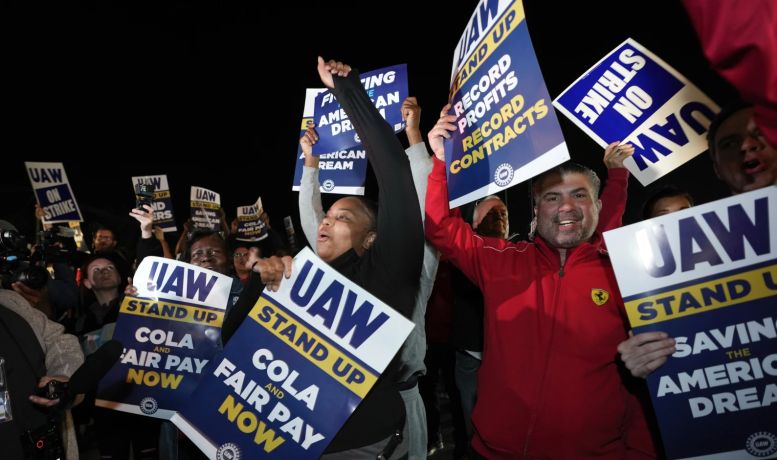Em Smith, Socialist Alternative, US
Tens of thousands of workers at Ford, General Motors, and Stellantis have been preparing for weeks to go on strike to fight for their demands, including a 40 percent raise. They have organized practice pickets, attended rallies, and tuned into UAW President Shawn Fain’s video livestreams to get the latest updates on negotiations.
If all these workers walked off the job, their numbers would nearly match the 185,000 UPS Teamsters who waged a historic 15-day strike in 1997, costing the company’s executives hundreds of millions of dollars and winning important gains for workers.
Auto workers are demanding a 40 percent raise over the four years of the contract, to match the 40 percent raise that Big Three CEOs have given themselves over the last four years. They are demanding an end to the hated “two-tier” system, which denies pension and healthcare benefits to new workers. They are demanding Cost of Living Adjustments (COLA) to keep up with soaring inflation. They are demanding protections against outsourcing, offshoring, and plant closures. And they are demanding a 32-hour work week for 40 hours pay.
These are bold, exciting demands. They reflect the fighting mood of the membership, which elected Shawn Fain and the new UAW leadership last year on a promise of reforming the union, whose recent leaders have had a reputation for corruption and sell-out contracts.
Past UAW leaders have squandered union members’ money. One union leader spent $60,000 on cigars. Another was found to have stashed $30,000 of members’ dues in his garage. These revelations shocked and outraged the members, for good reason.
Even more disastrously, these union leaders presided over a decades-long decline in living standards for UAW members, as they negotiated away key benefits like COLA, and allowed the Big Three bosses to introduce two-tier systems into the contracts. As a result, since 2003, auto workers’ real wages (accounting for inflation) have declined by at least 30 percent.
Shawn Fain was elected to reverse that trend.
In the weeks leading up to the contract’s expiration, Fain took an aggressive approach– in contrast with the business unionism of the past. He leaned into bold demands like a 40 percent raise and a 32-hour work week. He has had a more open approach to bargaining, with regular updates for members. He has fought back against many of the attempts of corporate media to carry water for the bosses.
Most crucially, he threatened to strike all three automakers simultaneously if the companies fail to offer an agreement acceptable to members by the deadline of September 14 (last night) at 11:59 pm. He said repeatedly: “September 14 is a deadline, not a reference point.”
In the last few days, however, Shawn Fain and the UAW leadership changed course from their fighting approach. First Fain began walking back some of their demands, including lowering their wage demand. Then, in a livestream on Wednesday, Fain backpedaled on his key threat to shut down production across the board at the Big Three.
He announced that the union had “invented a new way to strike,” dubbing it the “Stand Up Strike”.
If anyone hoped that the “Stand Up Strike” was an exciting, militant strategy to stop UAW’s profits, like the historic “sit-down strikes” of auto workers in the 1930s, they will unfortunately be disappointed. As the UAW website explains:
“The Stand Up Strike is a new approach to striking. Instead of striking all plants all at once, select locals will be called on to “Stand Up” and walk out on strike. As time goes on, more locals may be called on to “Stand Up” and join the strike. This gives us maximum leverage and maximum flexibility.”
Fain’s initial approach, and the members’ willingness to strike as shown by their 97 percent strike vote, have already forced significant concessions from the Big Three bosses. All three are now proposing close to 20 percent raises for union members.
But the Big Three’s contract offers still provide no COLA, no end to the two-tier system, no protections against plant closures, while the wage increases do not make up for the historic levels of inflation. It is far less than what workers need, and far less than what they can win with a powerful strike that shuts down the bosses’ profits.
Unfortunately, this “new” strike strategy from Fain is not new at all. It represents a return to the conservative tactics of recent decades–the tactics of union leaders who are afraid to hit the companies where it hurts: their profits. What makes a strike among the most powerful tools of the working class is that it allows us to cut off the bosses’ profits in their entirety until our demands are met. This strategy, unfortunately, does not accomplish that aim. It does not provide “maximum leverage” to workers at the Big Three. In fact, it’s quite the opposite. It limits the scope of the strike, it limits the pain to the company’s executives, and it therefore limits the bosses’ willingness to give in to workers’ demands.
Workers Strike Back stands in full solidarity with UAW workers, and we will join the picket line anywhere we can to support these strikes. We urge all of our supporters to do the same. We will do whatever we can to support a victory at the Big Three.
It is very important that UAW is striking against all three of the big auto corporations, and millions of workers are inspired by this strike in the US and globally.
However, it is also crucial to be clear about what is necessary to win. We call for the strike to be immediately extended to ALL UAW PLANTS to bring the full power of US auto workers to bear against the billionaire class.
Today, 13,000 UAW members are on strike at 3 plants in Wentzville Missouri; Wayne, Michigan; and Toledo, Ohio. This is important, and the labor movement must do everything possible to strengthen these picket lines.
At the same time, this is a tiny fraction — less than 10 percent — of Big Three workers. Workers at the largest and most profitable factories, like at Ford’s Kentucky Truck Plant (KTP) in Louisville, KY, are still working. This “targeted” strategy by UAW President Fain dramatically reduces the union’s leverage at a critical moment and represents only a fraction of the potential pressure UAW members could mount against the bosses. UAW members should get organized to quickly escalate towards a national shutdown of the Big Three, to completely halt the bosses’ profits. The current approach not only limits the union’s strength, but risks creating divisions within the union, as some workers continue to work and collect a paycheck, while others have to subsist on $500/week strike pay.
In his livestream address on Wednesday, Shawn Fain said: “We fight not only for the good of our union, or for the good of our members and our families. We fight for the good of the entire working class and the poor. I believe great things are possible, but only if we shed our fear. The only limits we have to worry about are the limits we put on ourself.”
Fain is right that big victories are possible. But unfortunately, he is now backpedaling in a dangerous and unnecessary way. His “Stand Up Strike” strategy puts major limits on the power of the union. If only a few factories go on strike, the Big Three will continue to rake in huge profits, shielding them from the effects of the strike. For the majority of UAW members, September 14 has indeed become a “reference point” and not a “deadline.”
Fain’s approach also puts the members who remain at work in increased danger, by having them work under an expired contract. As UAW leadership explains on the union website, members working under an expired agreement will not be protected by the contract’s arbitration process. The leadership’s advice is to “Carefully follow all standard operating procedures, safety policies and supervisor instructions.” They warn UAW members: “Don’t work slowly or refuse to do any of your job duties.”
UAW members would be much more powerful if they shut down every factory of the Big Three all at once.
UAW members should organize together to challenge this bad decision by union leadership and walk off the job as a united force of 150,000 auto workers. Hundreds of UAW members are already calling for this in the comments on Fain’s Facebook livestream. A united strike would put maximum pressure on the bosses and send a shockwave through the American working class. It would show workers everywhere what it means to be a fighting, rank-and-file union.
One UAW member put it succinctly in response to Fain’s video: “Strike together all at once. United we stand.”



